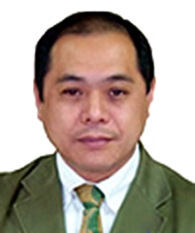Ph. D. (Kokugakuin University)
1901-1, Maseguchi, Miyota machi, Nagano, Japan,389-0207
E-mail: jomon(at)mx2.avis.ne.jp
Web Site http://www.avis.ne.jp/~tsutsumi/index2.htm
Born 1962 in Saku City, Nagano Prefecture, Japan
1901-1, Maseguchi, Miyota machi, Nagano, Japan,389-0207
E-mail: jomon(at)mx2.avis.ne.jp
Web Site http://www.avis.ne.jp/~tsutsumi/index2.htm
Born 1962 in Saku City, Nagano Prefecture, Japan
Education
1980-1984 Tokai University, B.A., Department of Japanese civilization.
1999-2002 Kokugakuin University, Ph.D. Archaeology.
1999-2002 Kokugakuin University, Ph.D. Archaeology.
Employment
1984- 2002: Curator of Miyota Town Board of Education, Nagano Prefecture.
2003- present: Chief Curator, Asama Jomon Museum, Miyota Town, Nagano Prefecture.
2016-present: Part-time lecturer, Tokyo University.
2003- present: Chief Curator, Asama Jomon Museum, Miyota Town, Nagano Prefecture.
2016-present: Part-time lecturer, Tokyo University.
Current Research
Lithic studies on the Upper Plalaeolithic age.
Lithic studies on the Jomon age.
Lithic studies on the Jomon age.
Honors
■Received the 17th Fujimori Eiichi Prize. June 1992, from Nagano Archaeological Association, Japan.
■Received the 10th IWAJYUKU-Culture Prize. November 2007, from Midori City, Gunma Prefecture, Japan.
■Received the 1st Japanese Paleolithic Research Association Grand Prize. June 2014, from Japanese Paleolithic Research Association, Japan.
■Received the 10th IWAJYUKU-Culture Prize. November 2007, from Midori City, Gunma Prefecture, Japan.
■Received the 1st Japanese Paleolithic Research Association Grand Prize. June 2014, from Japanese Paleolithic Research Association, Japan.
Academic Fellowship and Activities
Committee Member of Japanese Paleolithic Research Association.
Renewal Committee Member of National Museum of Nature and Science, Japan.
Renewal Committee Member of National Museum of Japanese History.
Renewal Committee Member of National Museum of Nature and Science, Japan.
Renewal Committee Member of National Museum of Japanese History.
Selected publications
| 2020 | Tsutsumi, T. (ed) What is the Mikoshiba Complex: Archaeology Quarterly No.153. Yuzankaku Co., Ltd., P.135. Tokyo. (in Japanese) |
| 2019 | Tsutsumi, T. Adventure archeology. Sinsensha Co., Ltd., P.245. Tokyo. (in Japanese) |
| 2015 | Tsutsumi, T. (ed) Yadegawa Site: Case studies of the microblade industry first discovered in the Japanese Archipelago. Shinmai Shiyoseki Co., Ltd., P.135. Nagano. ( in Japanese) |
| 2013 | Tsutsumi, T. Guidebook for the Mikoshiba Industries. Sinsensha Co., Ltd., P.94. Tokyo. (in Japanese) |
| 2012 | Asama Volcano. Hoozukishyoseki Co., Ltd., P. 200. Nagano.(in Japanese) |
| 2011 | Adaptive Strategies of the Microblade Hunters in the Last Glacial. Yuzankaku Co., Ltd., P. 357. Tokyo.( in Japanese with English abstract) |
| Palaeolithic Age in Japanese Islands. Kawadeshoboshisha Co., Ltd., P. 128. Tokyo.(in Japanese) | |
| 2009 | Guidebook for the Palaeolithic Studies in Japanese Islands. Sinsensha Co., Ltd., P. 94. Tokyo.(in Japanese) |
| 1997 | The Kashiwagaya-nagaosa Site. Kashiwagaya-nagaosa Site Investigating Group.P.506.Kanagawa. (in Japanese) |
| The Kawarada Site. Miyota Town Board of Education. P.635.Nagano .(in Japanese) |
Selected Monographs and Articles
| 2020 | Tsutsumi, T. The arguments of the Mikoshiba Industries. Communications of the Palaeo Perspective Vol.1: 18-29.Tsutsumi.T(ed.) Palaeolithic Learning, Opportunity and View. (in Japanese) |
| 2019 | Midoshima,T. and Tsutsumi, T. The Effectiveness of Microwear Analysis on Stone Tools: Blind Tests. Palaeolithic Research 15: 69-90. Japanese Paleolithic Research Association. (in Japanese) |
| 2018 | Tsutsumi, T. Episodes recorded on the three bifaces. An analysis of the life-histories of obsidian artifacts from the Mikoshiba site. Natural resource environment and humans: proceedings of the Meiji University Center for Obsidian and Lithic Studies 8: 1-16. Meiji University Center for Obsidian and Lithic Studies. (in Japanese) |
| 2015 | Tsutsumi, T. Obsidian exploitation, use and technological strategy of Microblade hunters. Tsutsumi, T. (ed) 2015 Yadegawa Site: Case studies of the microblade industry first discovered in the Japanese Archipelago: 402-420. Shinmai Shiyoseki Co., Ltd. (in English) |
| 2014 | Tsutsumi, T. and Mochizuki,A. Sourcing microblade assemblages of wedge-shaped microblade cores from the Nakappara 5B and 1G sites of the Nakappara site group. Natural resource environment and humans: proceedings of the Meiji University Center for Obsidian and Lithic Studies 4: 73-81. Meiji University Center for Obsidian and Lithic Studies. (in Japanese) |
| 2011 | MIS3 edge-ground axes and arrival of the first Homo sapiens in the Japanese archipelago. Palaeoenvironmental changes and human dispersals in North and East Asia during MIS3 and MIS2. Quaternary International 248:70-78. Ono,A., (ed.) INQUA. (in English) |
| 2010 | Prehistoric Procurement of Obsidian from Sources on Honshu Island (Japan). Crossing the Straits: Prehistoric Obsidian Source Exploitation in the North Pacific Rim. BAR2152:27-55. Kuzmin, Y. V., and Glascock M.D., (eds.) , Archaeopress. England. (in English) |
| 2007 | The Dynamics of Obsidian Use by the Microblade Industries of the Terminal Late Palaeolithic. The Quaternary Research 46-3:179-186,Japan Association for Quaternary Research. Tokyo.(in English) |
| 2006 | Microblade assemblage at the Yadegawa Site in Shigenari Yuri’s collection. The Bulletin of Meiji University Center for Obsidian and Lithic Studies 4: 97-124. Center for Obsidian and Lithic Studies, Meiji University, Nagano. (in Japanese) |
| 2004 | An Overview of the Obsidian Use in the Paleolithic at the Central Highland and Kanto, Honshu Island, Japan. Obsidian and Its Use in Stone Age of East Asia, pp.7-13, Meiji University.Tokyo. (in English) |
| Regionale Unterschiede im Jungplaolithikum, Zeit der Morgenröte :Japans Archäologie und geschichte biz zu den ersten Kaisern, Handbuch.61-66 Reiss-Engelhorn-Museen, Mannheim, Germany. (in German) | |
| 2002 | Obsidian resource exploitation in the Upper Paleolithic Japanese central highlands. Memoir of the Archeological Museum of Kokugakuin University18: 1-2.1 The Archeological Museum of Kokugakuin University. Tokyo (in Japanese) |
|
Origins of Pottery and Human Strategies for Adaptation During the Termination of the Last-glacial Period in the Japanese Archipelago, The Origins of Pottery and Agriculture, pp.241-262, Yasuda Yoshinori(ed), Roli Books. India. (in English)
|
|
| Environmental adaptation by the analysis of end-scrapers in the Upper Paleolithic Japan. Quarterly of Archaeological Studies 47-2: 66-84. Society of Archaeological Studies.Okayama. (in Japanese) | |
| The Japanese microblade industries: Technology, raw material procurement, and adaptations. In Origin and Spread of Microblade Technology in Northern Asia and North America 34:53-78. Kuzmin, Y. V., Keates, S. G., and Shen, C. (eds.), Archaeology Press, Department of Archaeology, Simon Fraser University. Canada. (in English) | |
| Radiocarbon dates and Archeology of the Late Pleistocene in the Japanese Islands. Radiocarbon, 44-2.:477-494. The Arizona board of regents behalf of the University of Arizona. U.S.A. (in English) |



